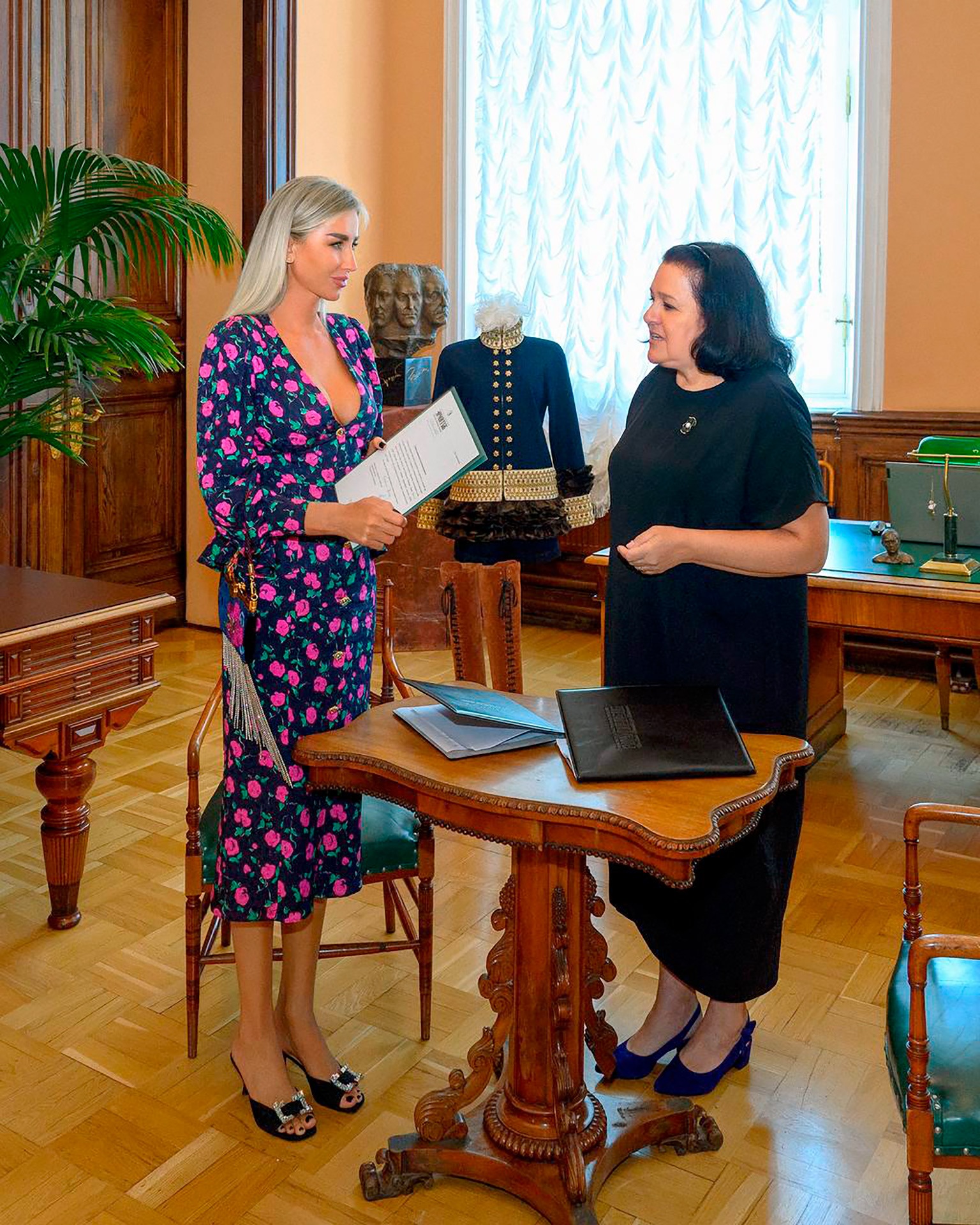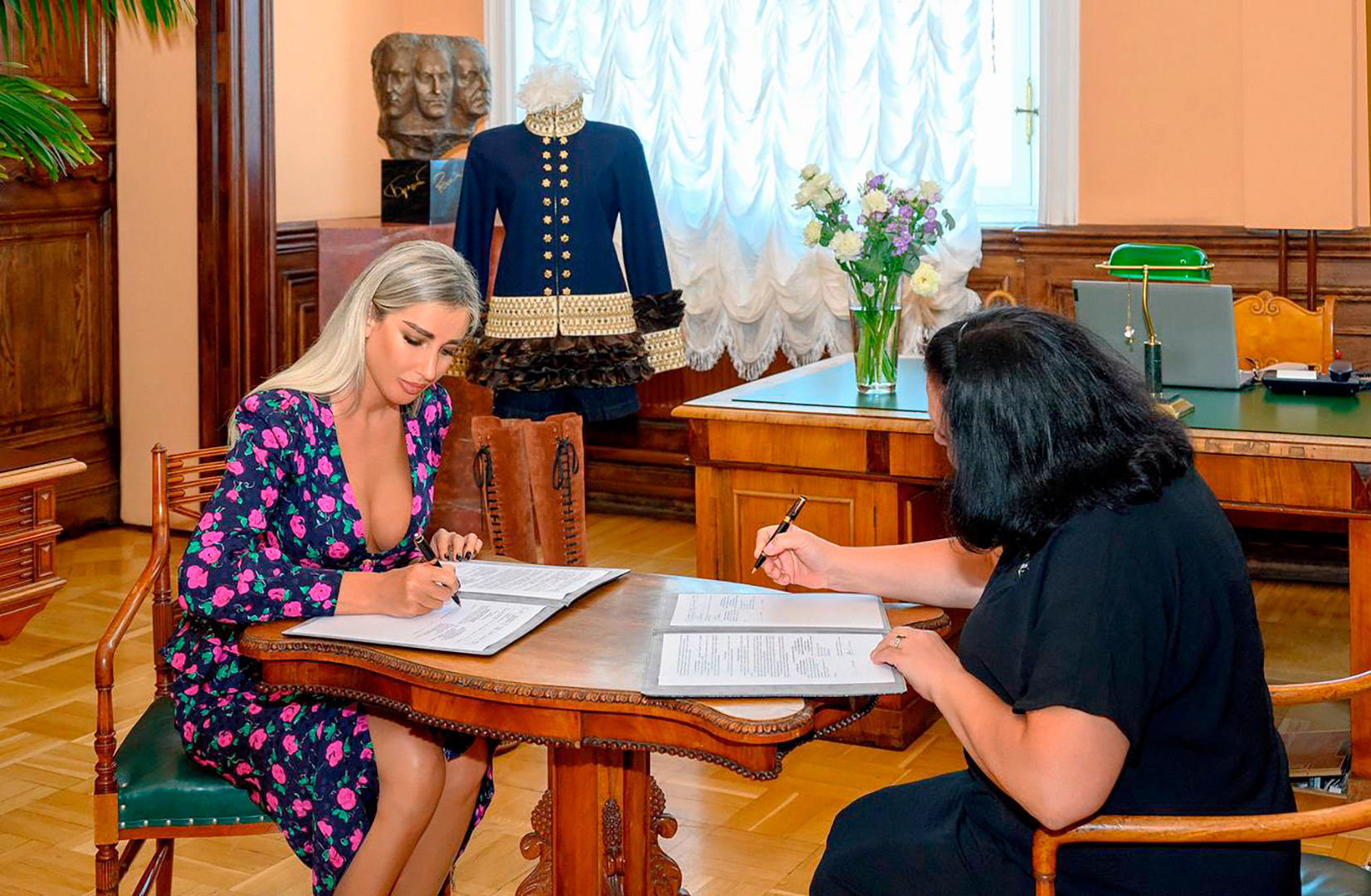Formal donation to the Hermitage of a costume by Karl Lagerfeld from the Chanel collection
On 12 July 2022, the State Hermitage was the setting for Olga Syrovatskaya’s ceremonial gifting to the museum of a runway costume that was produced in 2014 by the Chanel fashion house to the designs of the outstanding modern-day couturier Karl Lagerfeld.
The donation agreement was signed by Svetlana Borisovna Adaksina, Deputy General Director and Chief Curator of the State Hermitage, and Olga Vladimirovna Syrovatskaya as the donor.

Also participating in the occasion were Nina Ivanovna Tarasova, head of the Applied Art Section of the Department of the History of Russian Culture; Marina Alexeyevna Blumin, head of the New Acquisitions Section; and Yekaterina Mikhailovna Sirakanian, head of the State Hermitage’s Development Service. At the end of the formal ceremony, Svetlana Adaksina presented Olga Syrovatskaya with a letter of thanks.
“The costume collection in the Hermitage begins from the time of Peter the Great, and we are constantly expanding its chronological boundaries. We are pleased to be receiving the gift of this costume, which will occupy a worthy place in our collection,” Svetlana Adaksina stated.
“I bought this costume in 2015 and have never once put it on since. Recently, I decided to pass the outfit over to those in whose hands it will be cared for appropriately. I am tremendously happy to become a part of history and to make a contribution to the cultural development of our country. I hope that this will mark the start of collaboration between our club, the Olett Club, and the State Hermitage,” Olga Syrovatskaya said after the ceremony.
The set consists of a woman’s jacket, shorts and a pair of thigh-length boots. All the items were presented by Karl Lagerfeld at the celebrated Chanel Pre-Fall 2015 Métiers d’Art Show in Salzburg in the autumn of 2014.
The straight-cut jacket with long sleeves and a stand-up collar is made from a navy-blue woollen fabric, while the collar and cuffs are in a contrasting white woollen fabric decorated with embroidery using gilt elements: cord, flattened metallic thread, sequins and beads. A special role in the decoration is played by the metal zips made of a yellow alloy on the front of the jacket and around the bottoms of the sleeves, as well as the two rows of figured metal buttons running down the centre. The classically austere, almost uniform-like, appearance of the jacket is unexpectedly and strikingly set off by romantic features in the form of bird feathers arranged in three rows edging the hem of the jacket and the ends of the sleeves. An extremely delicate ruff of fine gauze and guipure lace “grows” in airy flounces from beneath the stiff stand-up collar.
The navy-blue denim shorts with a drop front that alludes to the famous soft-leather Austrian and Bavarian lederhosen, as well as to the similar arrangement found on army uniforms and sailors’ costumes in centuries gone by, are decorated with superbly executed three-dimensional embroidery using the trapunto technique. Stamped metallic coat-of-arms buttons stress the “uniform” component of the outfit.
The tall boot with massive, yet at the same time barely visible, transparent plastic soles are made from soft terracotta-coloured suede combined with black and white patent leather. The boots have laces at the front and fasten at the back with a plastic zip running from bottom to top. A Chanel “trademark” runs around the welt – a white alloy chain that has a strip of black patent leather threaded through its large links.
All the pieces in the outfit vividly demonstrate Lagerfeld’s love for Austria, for its fabulous palaces and castles, for the traditional clothing of Tyrolean huntsmen and the uniforms of the Viennese military academy. And, of course, the designer aims this at the self-confident modern woman who combines at one and the same time strength, decisiveness, delicacy and tenderness.
From 1983 to 2018, the famous fashion house Chanel was headed by Karl Otto Lagerfeld (1933–2019), a German designer, art collector, photographer and publisher. It was in this role that he came to international fame. At the time, Chanel’s fortunes were far from rosy: since the death of its founder Gabrielle “Coco” Chanel, none of that legendary figure’s successors had been able to replicate her achievements. The Chanel brand slowly went out of vogue, and the famous tweed suit began to be considered a garment for old ladies. Lagerfeld’s very first collection was a sensation, as models took to the catwalk in classic blazers and miniskirts. From then on, Lagerfeld created several collections a year, which are remarkably different from one another. His efforts made Chanel’s style dynamic and up-to-date. His work is permeated with an ironic austerity, contrasts, energy and extravagance, and he always managed to balance classic and cutting-edge fashion trends, something that is clearly in evidence in the set of pieces donated to the State Hermitage.
Until now, there has not been a single exhibit representing the Chanel brand in the Hermitage costume collection. The outfit donated to the museum is of unquestionable artistic and museum value and will be a serious addition to the stock of contemporary costume.

